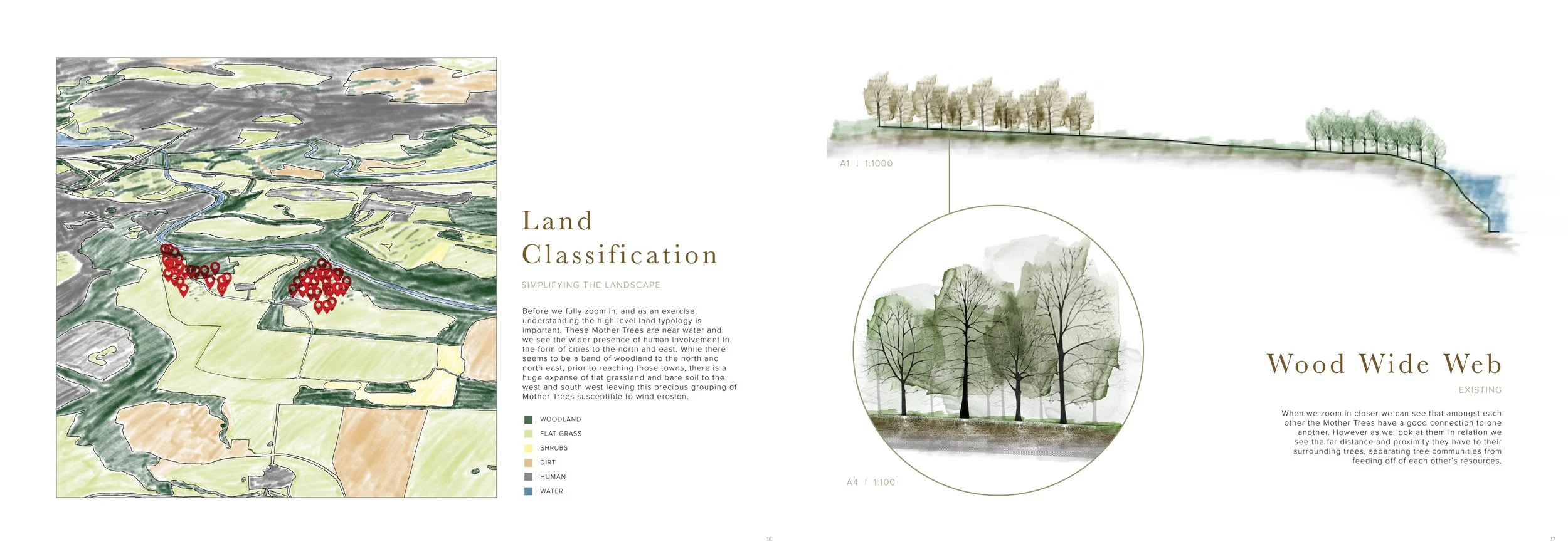
Protect Mother Tree / Earth
MLA - Year 2 | Fall 2022 | Location: Scotland | Course: Landscape Architecture Exploration : Part 1
Project Description
Assignment:
Select project topic of choosing for year long thesis. The only parameter was to focus on Scotland as a whole. Additionally this semester’s focus was on research and very top level, speculative design work. The following semester (currently under progress) is where we will dive deeper into our specific site and design.
Proposal:
For my year long project I chose to look at ancient Mother Trees - the oldest trees amongst others at the centre of this forest network, communicating, giving and protecting the other trees around them. They are “the glue that holds the forest together.” Just as mothers nurture their kin, they are essential for their young seedlings survival, providing them with their excess carbon and nitrogen through their fungal mycorrhizal network.
Even as Mother Trees reach the end of their life, they play vital roles to their community. When a mother tree dies, through decay and decomposition, a time travel-like process is initiated, releasing their pristine ancient mind, body and soul to their community and environment. They pass their wisdom on to their kin, such as what is harmful to them, who is a friend or foe, how to adapt and survive in the ever changing landscape.
As we search for more sustainable ways to make and build, timber can be seen as a smart choice as it is at times more sustainable than plastics, concrete or steel. Therefore the demand for timber is still needed and tree plantations are often deemed as a smart choice in order to not try and not deforest existing woodlands
I propose to strategically design and re-define tree plantations by creating an autonomously regenerating tree plantation that not only serves its human centric function for timber harvesting but simultaneously protects the soil and Mother Trees by dually establishing a linked tree community network. These autonomous tree plantation webs will be strategically placed around mother trees to preserve a piece of history and their vital role within the ecosystem. This map can then be used as a formula to be implemented across other varying landscapes and for other lone Mother Trees.
For this semester I chose to focus on two different sites; one in the Lowlands and one in the Highlands.
Branding
Exhibition Design
Project Proposal
Site A
Lowlands | S. Lankshire | Quercus
The site in South Lanarkshire country of the Lowlands contains a large grouping of species Mother Trees. It was primarily selected as a case study for the autonomous tree plantation web due to its large grouping of Mother Trees, lowland location and adjacent location to an urban environment. Additionally these Mother Trees reside near a PAWS plantation, another important reason for its selection.
Oak trees have long been regarded as symbols of patriotism, royalty and strength as ancient kings and emperors wore crowns of oak leafs. In mythology oak was sacred to many divinities like Zeus and Jupiter. They can live to be older than 1,000 years old, sustaining 2,300 wildlife species for centuries - 326 species depend on oak for survival! Even after oak trees enter decay their deadwood is incredibly valuable for certain species such as the green woodpecker who use and eat their wood as it is often softer and easier to break down. Furthermore, specific beetle and fungi species exclusively breed in dead oak trunks.
In this site there are a tremendous amount of Mother Trees, a mix of oaks and Quercus robur (Pedunculate oak). The description therefore of the Mother Trees varies as well as its size.
Site B
Highlands | Aberdeenshire | Castanea sativa
The site in the Aberdeenshire county of the Highlands contains the singular Castanea sativa Mother Tree. It was primarily selected as a case study for the autonomous tree plantation web due to its proximity to the Highland Boundary fault line. Understanding if its proximity would influence any of the invisible environmental actors was of interest. Its further split soil profile, suitability for forestry, Highland representation, lone Mother tree status and surrounding abandoned land, were amongst some of the other reasons it was selected. Additionally its existing arrangement of already being quite literally encircled by some existing woodland shows the organic start of the autonomous tree plantation web shape. Therefore, utilising what is already there and expanding upon it, makes this a unique and excellent case study.
There is little mythology about the sweet chestnut; however the ancient Greeks dedicated the sweet chestnut to Zeus. Castanea comes from Castonis, a town in Thessaly, Greece where the tree was grown for its nuts. The Sweet chestnut tree is uncommon in Scotland and was introduced into the UK by the Romans for its nuts; however, it now behaves like a native tree. It has lots of small branches coming out of it, starting quite close to the base of the trunk. Its bark has a wide undulating ribbed structure.

















